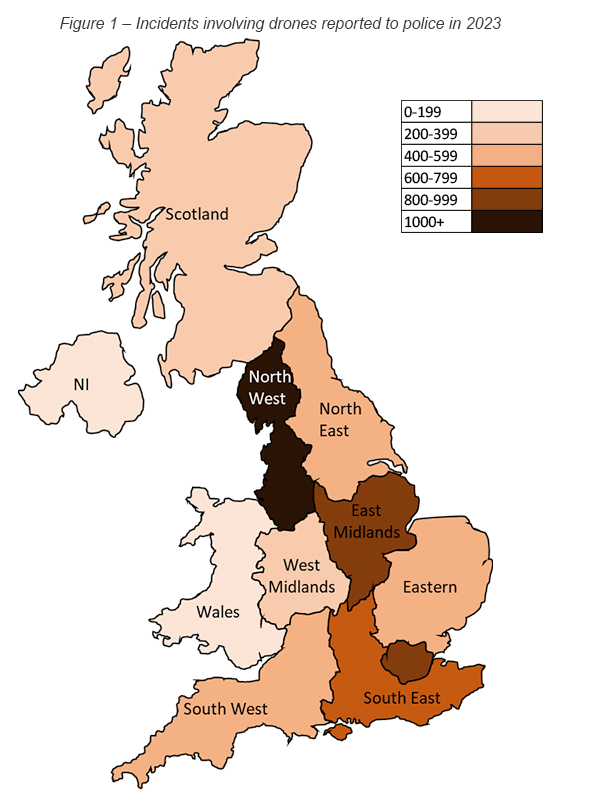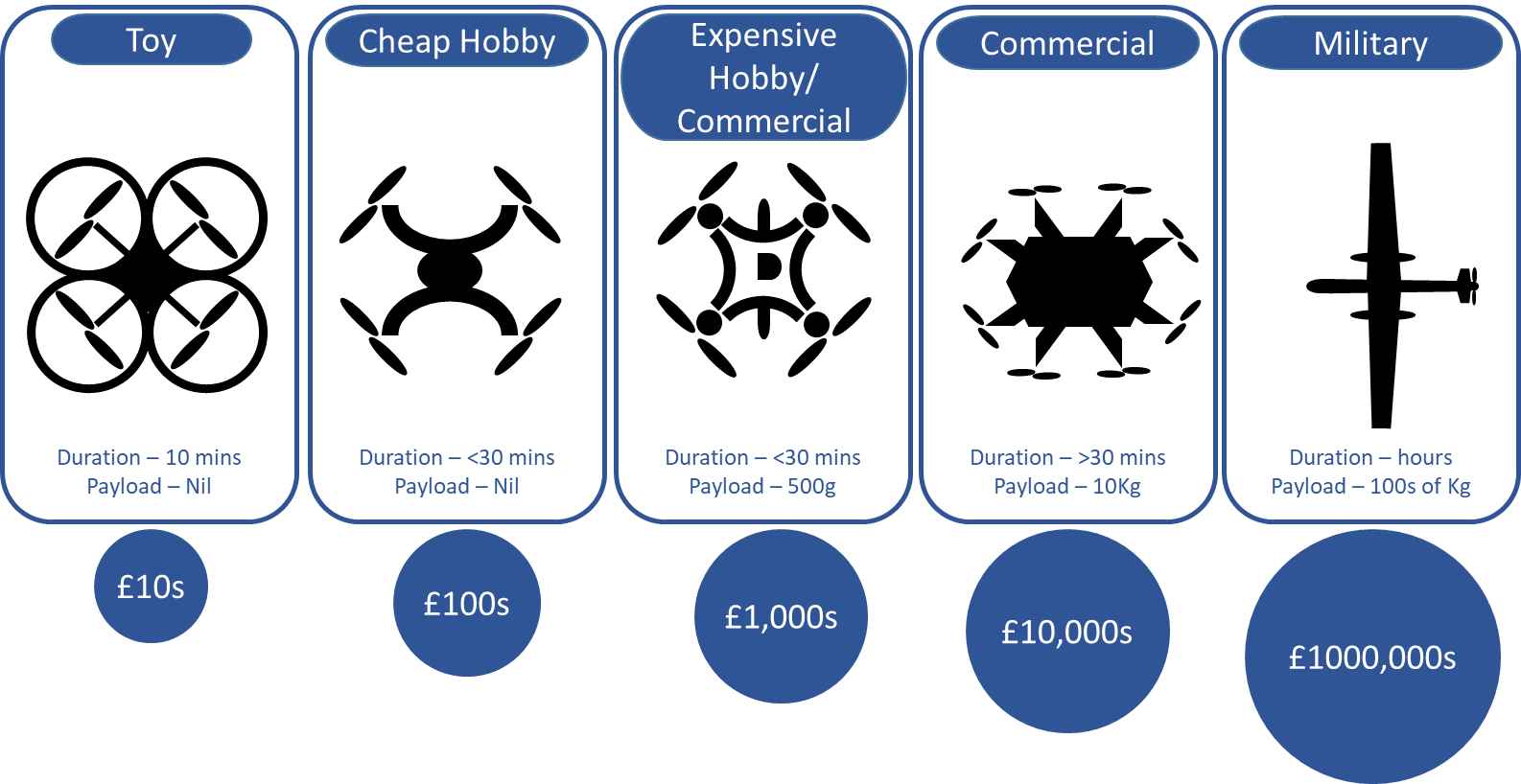What is a Drone?
A drone is the common term used to describe an un-manned, remotely-controlled or autonomous vehicle. This assessment is concerned with the threat from airborne drones which are more correctly referred to as Unmanned Aerial Vehicles (UAVs).
Headline Assessment
- A wide variety of UAVs are available in the UK. The vast majority of users possess and operate drones for perfectly lawful reasons.
- During 2023 over 6000 incidents involving drones were reported to police. Only a small proportion (approximately 11%) constituted offences.
- The conflict in Ukraine has highlighted the ease with which civilian drones can be adapted for military purposes and used to mount successful attacks. It is likely that terrorists will seek to learn from these developments.
- While terrorist groups have made extensive use of drones in overseas conflicts, the use of a weaponised UAV in a terrorist attack in the UK is unlikely in the next 12 months. This is due to a number of factors including the need for technical expertise and availability of cheaper alternative methodologies. However, this does not preclude terrorists from employing UAVs as the weapon itself or in roles outside an attack such as hostile reconnaissance.
What is a drone?
A drone is the common term used to describe an un-manned, remotely-controlled or autonomous vehicle, which is designed to be land-based, submersible or airborne. This assessment is concerned with the threat from airborne drones which are more correctly referred to as Unmanned Aerial Vehicles (UAVs).
Until recently, UAVs were primarily the preserve of the military due to their complexity and expense. Over the last decade the technology has become much more widely available and cheaper, so that a wide range of small to medium-sized UAVs are affordable to the hobbyist and professional user alike. Consequently, UAVs are being used in an increasing number of legitimate applications from crop-spraying to geological survey and from border surveillance to aerial photography.
Furthermore, Commercial Off-The-Shelf (COTS)1 UAVs can be modified or upgraded to improve their performance or capabilities. In 2019 the House of Commons Defence Committee heard evidence from experts on the domestic threat from drones. They stated that videos shared on social media demonstrated that UAVs had been successfully modified by hobbyists in the UK and US to deploy a variety of weapons such as handguns, flamethrowers and even chainsaws. There was nothing to suggest there was any malicious intent behind these videos, but simply to show what was possible. Nevertheless, such modifications could be used for nefarious purposes, including terrorism.
How much illegal drone activity is there in the UK?
A wide variety of UAVs are available in the UK. As of 31 March 2023 there were 513,860 active drone flyers and operators registered2 in the UK according to the Civil Aviation Authority. However, the true number of drone users in the UK is almost certainly higher. Nevertheless, the vast majority of users possess and operate drones for perfectly lawful reasons.

During 2023 over 6000 incidents involving drones were reported to police. This activity took place throughout the UK, but was mainly concentrated in urban areas in London, East Midlands and North West (see Figure 1). Of the reported drone activity only a small proportion (approximately 11%) constituted a criminal offence.
Approximately 13% of all reports related to drones flying at or close to airports, predominantly within Flight Restriction Zones. Even if this activity was careless or negligent rather than malicious, it still posed a risk to manned aircraft. Activity of this type is a criminal offence without proper permissions in place. In December 2018, reports of drone sightings at Gatwick Airport grounded around 1,000 flights for almost 36 hours, affecting more than 140,000 passengers at an estimated cost of £50-70 million.
Around 31% of reports relate to drone activity linked to suspected illicit deliveries to prisons. Drones are known to have been used to deliver contraband such as drugs or mobile phones to inmates in prison. This continues to pose a significant challenge to prison authorities.
Approximately 3% of drone activity was reported in the vicinity of sensitive or military sites. Whether wilful or not, this demonstrates the potential for gaining access to such sites. Additionally, media reporting of such activity can highlight vulnerabilities or opportunities to terrorists. In June 2021, a drone user fined more than £5,000 for flying illegally over MI6's HQ in London received media attention.
The bulk of the remaining reports relate to sightings of suspicious, anti-social or reckless activity on private property or in a built-up area. These reports often do not contain sufficient details about what the drone was doing or why it was deemed suspicious. Consequently, it is difficult to ascertain how much of the drone activity reported to police represents intentionally malicious or criminal use of drones.
The bulk of the remaining reports relate to sightings of suspicious, anti-social or reckless activity on private property or in a built-up area. These reports often do not contain sufficient details about what the drone was doing or why it was deemed suspicious. Consequently, it is difficult to ascertain how much of the drone activity reported to police represents intentionally malicious or criminal use of drones.
Certain types of illegal activity almost certainly involve the use of modified drones to overcome barriers to such activity. For example, drone software would have to be modified in order to remove automated restrictions, which would allow it to be flown within restricted airspace including over prisons, near to airports, and other sensitive locations.
How have drones been used by terrorist groups?
One of the earliest uses of a remotely piloted vehicle in a terrorist plot was in 1994 when Aum Shinrikyo, the Japanese apocalyptic cult responsible for the Tokyo subway chemical attack the following year, attempted to use a remote-controlled helicopter to spray a chemical gas.
In the early 2000s a number of plots linked to al-Qaida (AQ) emerged where the use of drones was considered, but it is not clear how many of these were credible. At the same time groups such as Hamas and Hezbollah were experimenting with weaponised model aircraft to deploy against Israel.
There is no definitive list of terrorist attacks using UAVs. However, according to data collected by the National Consortium for the Study of Terrorism and Responses to Terrorism (START), between 2015 and 2019 there were at least 114 instances of terrorist use of drones globally. Almost all of these took place in the Middle East with approximately half located in Syria and Iraq. A notable exception is the failed assassination attempt of Venezuelan President Maduro by two GPS–guided drones laden with explosives in Caracas in August 2018.
There has almost certainly been greater use of drones by terrorists than the START data suggests, and this use will not have been confined to just mounting attacks. It is known that modified commercially available drones have also been used in Syria and Iraq by terrorists to conduct reconnaissance and filming for propaganda purposes, most notably by Daesh.
More recently, the conflict in Ukraine has also highlighted the ease with which civilian drones can be adapted for military purposes, and used to mount successful attacks against opposing forces. It is likely that terrorists will seek to learn from these developments.
How could terrorist drone use manifest in the UK?
While the technology has been exploited by terrorists overseas, to date there has not been a successful deployment of a UAV in an attack by a terrorist group in the UK. However, there has been a recent case of a terrorism conviction which involved the manufacture of a drone.
In 2023, a Phd student who was a supporter of the Islamic State in Syria and Levant (Daesh), was convicted of terrorism offences after he was found to be designing and building a drone for use overseas by the terrorist group. It is not clear how viable the drone would have been had it been completed.

Figure 2 – Capability and Cost of the various classes of UAV
The use of a weaponised UAV in a terrorist attack in the UK is unlikely in the next 12 months. Although UAVs offer distinct advantages over traditional terrorist methodologies (such as access to difficult to reach targets and remote operation), there are a number of barriers to their adoption by terrorists in the UK.
Firstly, purchasing and adapting a COTS drone with a sufficient payload capacity would be prohibitively expensive (see Figure 1). Additionally, weaponising UAVs would require considerable technical skill. However, this does not preclude terrorists from employing a UAV as the weapon itself or in roles outside an attack such as hostile reconnaissance.
What does this mean for business and the Public?
Businesses and members of the public play a vital role in alerting the authorities to suspicious activity preceding a terrorist attack. This can include sightings of UAVs in the vicinity of government, military, sensitive or high-profile sites such as the Houses of Parliament or Buckingham Palace.
Further advice can be found here:
1 These are UAV’s which are produced as standard products for commercial and industrial uses that are adapted by the customer rather than commissioning of bespoke solutions. Whilst principally aimed at the civilian market, COTS products are increasingly being adapted by military users as a more cost effective way to develop their capabilities.
2 Since 30 Nov 2019, drones that are not a toy and have a camera are required by law to be registered with the Civil Aviation Authority before they can be legally flown outdoors in the UK.
Probability and Likelihood in Intelligence Assessments
When describing threats in intelligence assessments, Counter Terrorism Policing utilises the Probabilistic Yardstick.
The Probabilistic Yardstick is a tool created by the Professional Head of Intelligence Analysis (PHIA), in the UK government, to standardise the way in which we describe probability in intelligence assessments. For example, if we use the term ‘likely’ what we mean is ‘a 55-75% chance’.
Use the scale below as a reference when reading ProtectUK Insights.


